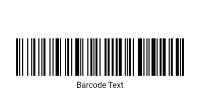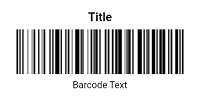Code 128A is one of the three subsets of the Code 128 barcode symbology, designed for alphanumeric or numeric-only barcodes. It is part of the Code 128 family, which includes Code 128A, Code 128B, and Code 128C, each optimized for different types of data. Code 128A is particularly suited for encoding uppercase letters, numeric digits, and a limited set of control characters.
Developed in 1981 by Computer Identics, the Code 128 barcode was designed to provide a high-density alphanumeric symbology. The versatility and compactness of Code 128 have made it a standard in various industries, especially where large amounts of data need to be encoded in a small space.
Technical Specifications
Code 128A can encode all standard uppercase alphabetic characters (A-Z), numeric digits (0-9), and several control characters and punctuation marks. Each character is represented by a unique pattern of bars and spaces of varying widths, which is part of a larger set of 106 different bar and space patterns.
A Code 128 barcode consists of the following components:
- Start Character: Code 128A uses the start character ‘START A’ to indicate the beginning of the data sequence.
- Data Characters: Each character in the data sequence is encoded using a pattern of three bars and three spaces.
- Check Character: A modulo 103 checksum is calculated from the data characters to ensure data integrity.
- Stop Character: The stop character signals the end of the barcode.
Checksum Calculation
The checksum character in Code 128 is vital for ensuring the accuracy of the data scanned. The checksum is calculated using the following steps:
- Assign a unique value to each character based on its position in the character set.
- Multiply each character’s value by its position in the data string (starting from 1).
- Sum these products.
- Divide the sum by 103 and take the remainder.
- The remainder corresponds to a character in the Code 128 set, which is added as the checksum character.
Applications
Code 128A is used across a variety of applications due to its ability to encode complex data efficiently:
- Logistics and Shipping: Used to encode shipment tracking numbers, ensuring packages are correctly routed and delivered.
- Inventory Management: Facilitates the encoding of item identifiers and stock-keeping units (SKUs), aiding in efficient stock control.
- Healthcare: Employed in patient identification systems and medical records management, providing a reliable method to encode patient IDs and other critical information.
- Retail: Used on product labels to encode item numbers, simplifying the checkout process and inventory tracking.
Advantages and Disadvantages
Code 128A offers high density, meaning it can encode a large amount of data within a relatively small space, which is particularly useful in applications where space is limited. Its versatility is another key benefit, as it can encode uppercase letters, digits, and control characters, making it adaptable for various uses. Additionally, the inclusion of a checksum character in Code 128A enhances data integrity by ensuring accurate data transmission.
Despite its advantages, Code 128A comes with certain drawbacks. The complexity involved in encoding and decoding Code 128A can be higher compared to simpler barcode types, potentially making it more challenging to implement. Furthermore, while most modern scanners are capable of reading Code 128, older or less sophisticated scanners may struggle with decoding it, which could impact its effectiveness in certain settings.
Comparison with Other Barcode Symbologies
Code 128A presents several advantages over other barcode types, each of which has its own unique strengths and limitations. For instance, the Universal Product Code (UPC) is widely used in retail for item identification due to its simplicity and ease of use. However, UPC barcodes are limited to encoding only numeric data, making them less versatile compared to Code 128A, which can handle both numeric and alphanumeric characters.
Similarly, the European Article Numbering (EAN) system, while akin to UPC and used internationally, shares the same limitation of encoding only numeric data. EAN barcodes, therefore, do not offer the expanded functionality of Code 128A. The EAN's focus on numeric data restricts its application in contexts where alphanumeric encoding is required.
On the other hand, Code 39 supports both numeric and alphanumeric characters but is less compact than Code 128A. This results in larger barcodes for the same amount of data, making Code 39 less efficient in terms of space utilization. Additionally, the MSI barcode, which is primarily numeric, lacks the versatility of Code 128A due to its inability to encode alphabetic characters. This makes Code 128A a more versatile choice for applications needing to encode a broader range of characters in a more compact format.


